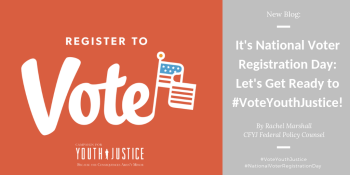It's National Voter Registration Day: Let's Get Ready to #VoteYouthJustice!

By Rachel Marshall, CFYJ Federal Policy Counsel
It seems like no matter where you turn these days, everyone is talking about the 2018 election, including the Campaign for Youth Justice. As we approach the kick off of Youth Justice Action Month in October, we’ve been focused on highlighting the issues that impact young people and why, when you head to the polls on November 6, you should #voteyouthjustice. While public safety often makes it onto the public polls and local political platforms, we spend little time re-imagining justice for our young people. In fact, three out of four people in local courtrooms—district attorneys, sheriffs, and some judges—are in elected positions. Their decisions directly affect our daily lives, especially when it comes to policing and the public safety of our most vulnerable population, our children.
While it’s critical to learn about your candidates at the local, state, and federal level, there’s an even more important first step you need to take to ensure you can #voteyouthjustice: register to vote! In 2016, an abysmal 56% of the voting-age population actually cast a ballot in the presidential election. That percentage is typically lower during non-presidential election years like 2018, and the numbers are even lower for youth, whose midterm turnout is around 20% nationwide.
From youth justice issues to education, healthcare, the environment, immigration, and many more, so many decisions made by our elected officials impact young people. Yet many young people do not even learn how they can register to vote and how to vote once they’re registered. Take Texas, for example. State law requires highs schools to explain to all seniors how to register to vote, yet students across the state report that they’re not receiving this information. According to a report from the Texas Civil Rights Project, only six percent of Texas schools actually requested voter registration forms from the Secretary of State ahead of the 2016 election.
Luckily, there are plenty of great resources out there to help teach young people about the voting process. Rock the Vote has teamed up with Teaching Tolerance, a project of the Southern Poverty Law Center, to relaunch their 2010 Democracy Class. The free, nonpartisan curriculum educates high school students about the history of voting and pre-registers and registers young people to vote. It can be used by teachers, community leaders, youth groups, and even politicians. If you think you’re registered, but you’re not sure, you can check your voter registration status on Vote.Org.
Once you’re registered to vote, make sure you know how to vote, whether it’s by absentee ballot or on election day. Rock the Vote also has information on each state’s voting laws, including how to register (and links to where you can register in your state), when you can vote, and what you’ll need to vote. Many states allow you to vote ahead of Election Day, by either sending in absentee ballot or voting early in person at your local board of elections. Whatever way you choose to vote, make sure you have a plan! You can also go to your local election board’s website to find a sample ballot so you know which candidates and issues are on the ballot.
Finally, remember your vote counts! While it might not always feel that way, every vote matters. In Virginia last year, an election for a seat in the Virginia House of Delegates ended in a tie. Ultimately, the winner was selected by pulling a name out of a bowl. While this type of ending in an election is rare, there are many more stories of elections coming down to just a couple hundreds of votes. Make sure your voice is heard this election year, and make sure you #voteyouthjustice!

